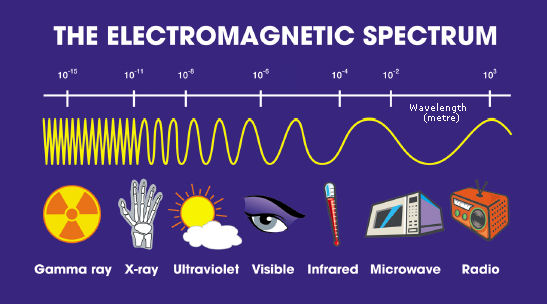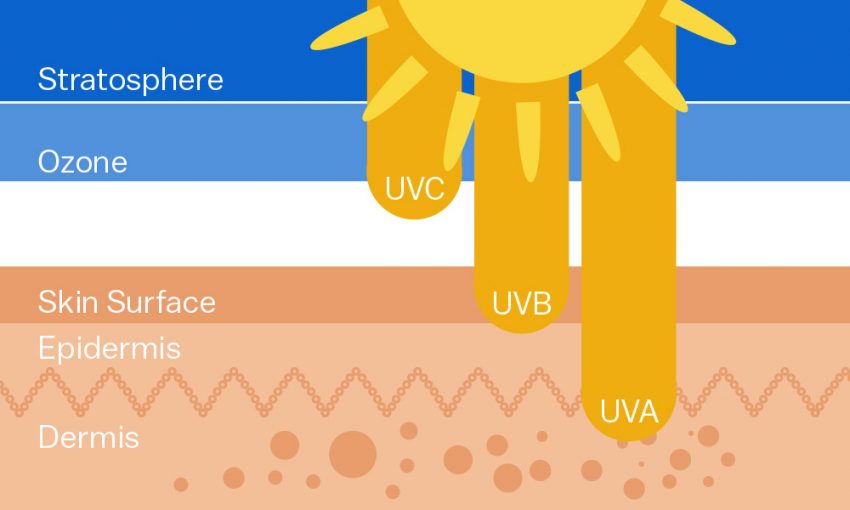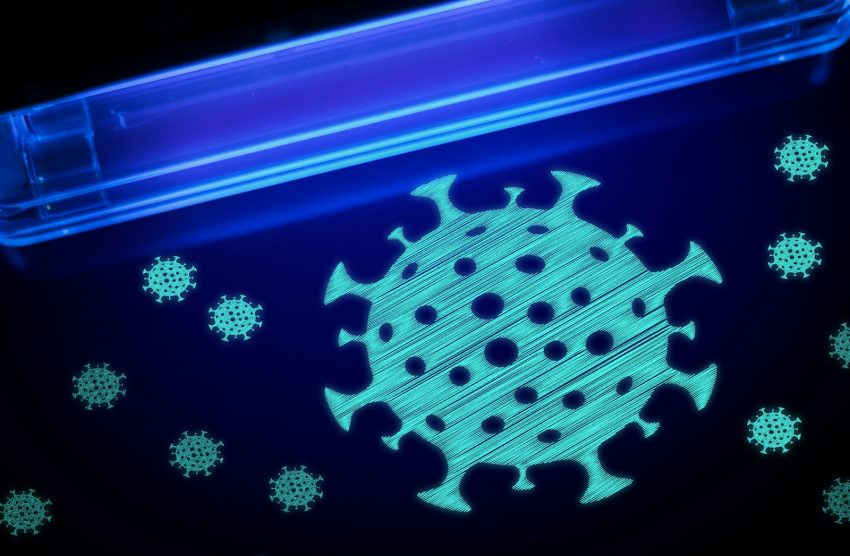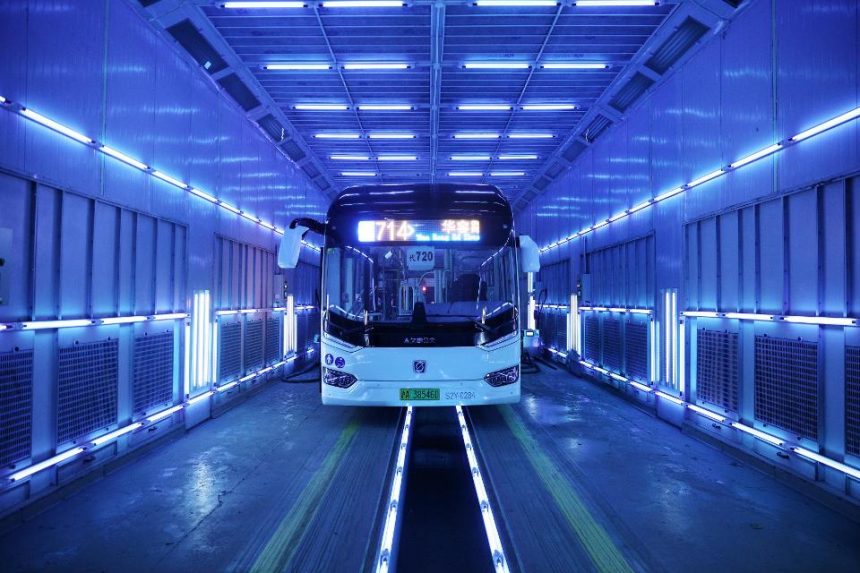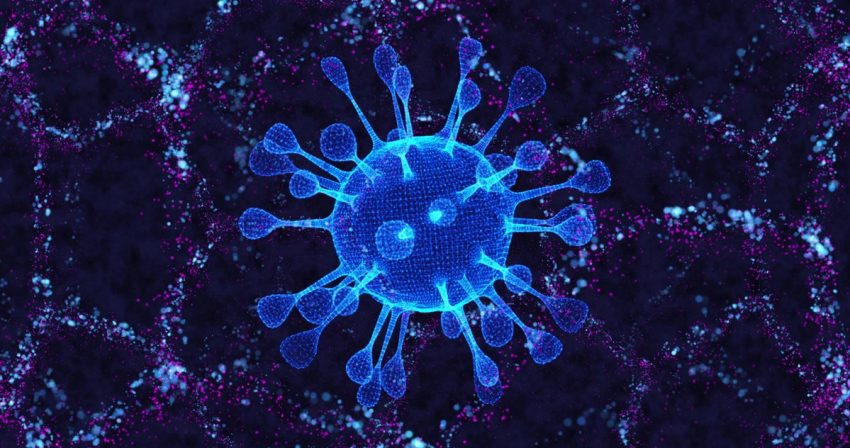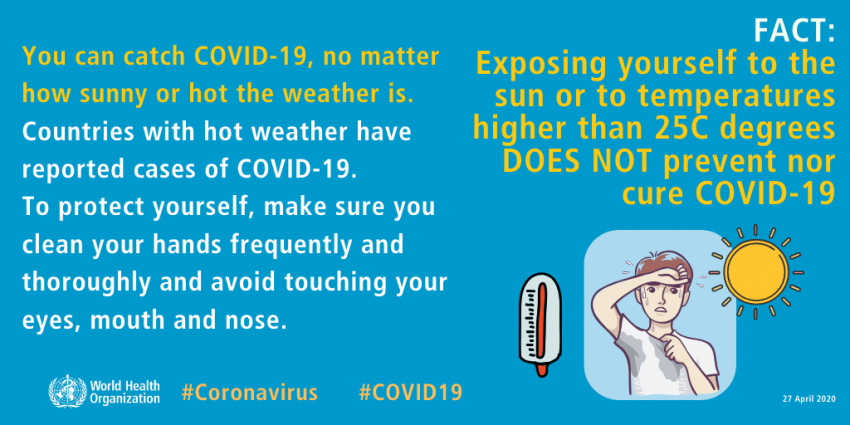Many common disinfectants are in short supply due to the COVID-19 pandemic, which has caused increased demand and supply chain disruptions. Now businesses are looking for alternative methods of sterilizing and sanitizing their properties against viruses, bacteria, and other pathogens. One solution is ultraviolet light, but what is UV light, and how does it work? We explored the science to bring you the truth about whether or not UV light kills bacteria.
What is UV light, and how does it work against viruses?
Ultraviolet (UV) light is part of the light spectrum beyond our ability to see. It’s a form of electromagnetic (EM) radiation, the same as radio waves, microwaves, and X-rays. Some of the visible light spectrum that we see is also EM radiation. That might sound scary, but we are exposed to EM radiation every day through sunlight, a portion of which contains UV light.
THE ELECTROMAGNETIC SPECTRUM
- Gamma radiation
- X-ray radiation
- Ultraviolet radiation
- Visible light
- Infrared radiation
- Microwave radiation
- Radio waves
As well as causing our skin to age if we get too much sunlight, UV light also has germicidal properties, meaning ultraviolet light kills bacteria and harmful microbes. That makes UV light an appealing option for sterilizing buildings and property. There’s no mess, no cleanup, and no ongoing supplies and equipment costs once you’ve invested in a UV light emitter. And because UV light works by disrupting the cells of microorganisms using radiation waves, there’s no risk of a virus or bacteria mutating to become resistant to its effects.
The history of UV lights for disinfection
The benefits of UV light for disinfection have been known for a long time, and the technology to use these light rays to kill viruses has been in use for about a century. Today ultraviolet technology is used in a number of industries, including at medical facilities, wastewater treatment plants, and in food preparation and pasteurization processes.
The ultraviolet light spectrum stretches from about 10 nanometers to 400nm, with 265nm being the most effective germicidal wavelength. At that wavelength, UV light damages the DNA and RNA (another crucial nucleic acid) of microorganisms, preventing them from reproducing and rendering them harmless. UV lamps emit most of their light at around 254nm, maximizing their germicidal potential.
Even before ultraviolet germicidal lamps were invented, people were already harnessing the power of UV light as a sterilizing agent. As early as the 1860s, Florence Nightingale observed that exposure to sunlight had a positive impact on wound healing, and if you’ve ever left musty clothes outside for a few hours, you’ve used the same beneficial UV light as a disinfectant. Sunlight is a natural disinfectant because of its UV spectrum rays, and opening curtains or blinds and letting sunlight into your home really does make it fresher and healthier.
UV LIGHT AS A DISINFECTANT IN HISTORY
1863 – Florence Nightingale reported sunlight’s positive effects on wound healing
1877 – experiments showed sunlight inhibited the growth of bacteria in sugar water
1890 – microbiologist Robert Koch demonstrates that sunlight kills TB bacteria
1936 – scientists discover sunlight kills E. coli bacteria
Types of ultraviolet light for disinfection
There are three types of UV radiation, known as UVA, UVB, and UVC. Each type has a different wavelength, and reacts differently in the atmosphere.
THE UV LIGHT SPECTRUM |
|||
TYPE OF UV LIGHT |
UVA |
UVB |
UVC |
WAVELENGTH |
315-399 nm |
280-314 nm |
100-279 nm |
ABSORPTION |
Not absorbed by ozone layer |
Mostly absorbed by ozone layer |
Completely absorbed by ozone layer |
Source: CDC
UVC is the only type of germicidal UV light, as the germicidal spectrum is 100-280nm. It’s also the type that is the least likely to reach the earth’s surface, as it is absorbed by the ozone layer.
So how does sunlight work as a disinfectant if no UVC gets past the ozone layer? Scientists aren’t entirely sure, but it’s likely that UVA and UVB light creates chemical reactions that speed the disinfection process, as well as having some mild disinfecting properties of their own. UVA light is known to react with the dissolved oxygen in water and create unstable molecules such as hydrogen peroxide, a known cleaning solution. The WHO recommends the SODIS system for purifying water when other treatments aren’t available. The method involves leaving water in direct sunlight for several hours in order to kill any pathogens it contains.
The use of ordinary sunlight to destroy microbes has been studied extensively. The flu virus has been found to become less infectious when exposed to sunlight, which is why we have a flu season when sunlight is typically weaker, making the virus more potent. However when scientists studied the coronavirus that causes SARS—a virus in the same family as COVID-19—they discovered that exposure to UVA light (sunlight) for fifteen minutes had no impact on how infectious it was.
While research is still ongoing to better understand how UVA and UVB light affect pathogens, and how specific viruses can be killed or suppressed using these wavelengths, only UVC light has truly germicidal properties.
What is UVC light?
Most of the UV light that reaches us from the sun—about 95 percent—is UVA light. The other five percent is UVB. UVC light is absorbed so completely by the ozone layer that no measurable amount reaches the surface of the earth. The only sources we have of UVC light are artificial, such as UVC LEDs and mercury lamps.
When organisms are exposed to UVC light, it penetrates cells and is absorbed by the DNA and RNA, damaging the cell’s structure and destroying its replication processes. If a pathogen cannot reproduce, it cannot cause an infection, therefore the damage done by UVC light is enough to render viruses and bacteria harmless, even if it doesn’t kill them outright.
In order to provide effective germicidal treatment, the UVC light has to be in close proximity to the surface being treated. UVC intensity from sources such as LEDs falls off exponentially, meaning the father away the light is, the less UVC light reaches the target object. In order to kill a pathogen, large doses of UVC would need to be administered from a short distance. However as all that is required to neutralize microorganisms is to destabilize the cell’s DNA and prevent it from replicating, UVC treatment can be effectively applied at lower doses and greater distance and have the same germicidal effects.
Far-UVC light
The recent discovery of another kind of UVC light has raised new hopes of engineering safer and more effective UV disinfection methods. Far-UVC light has a wavelength of 207-222nm, making it strongly absorbable by biological materials. Surprisingly, it’s this factor that makes it safer for human exposure. Far-UVC is so absorbent that it doesn’t penetrate even the outer layer of dead cells that cover our skin. However because microorganisms are so small—less than 1nm in diameter—far-UVC is highly effective at penetrating and destroying them.
The discovery of far-UVC opens the possibility of creating a UV light disinfection system that can be employed while people are present, such as at the entrance of grocery stores, on public transport, or in hospital waiting rooms. Currently UV light treatments can only be employed in empty spaces, such as in operating theaters and train cars while out of service. Although highly effective, these UV treatments have no prophylactic effect, meaning as soon as they are completed the area can become recontaminated. UV light treatment using far-UVC is one possibility to provide ongoing decontamination in public spaces.
RELATED: Here’s how to protect yourself from COVID-19 while you’re grocery shopping.
The benefits of UVC light for disinfection
Although potentially harmful if handled incorrectly, UVC light is highly efficient at decontaminating large areas, sterilizing both the air and all surface types. UV light treatments in general are preferred for their ease of application, short activation time, and suitability of use across all materials. Light treatments are non-toxic, environmentally friendly and affordable cleaning solutions, and pathogens cannot develop immunity to them.
All three types of UV light have some benefit when it comes to disinfecting and sterilizing, but UVC is the most effective, as it is the only type of UV light that has a germicidal wavelength. This means that treatment with UVC is much faster and more effective than with other types of UV light, which may require minutes or even hours of exposure, and cannot neutralize every microbial threat.
UV light disinfection for homes
With so much potential in ultraviolet light disinfection, it’s no surprise that demand for at-home UV light systems has increased dramatically since the COVID-19 pandemic started. However at-home UV sanitation wands are not regulated and have not yet been studied for effectiveness or tested for potentially harmful radiation emissions.
Even if at-home UV light sanitizers are found to be completely reliable, they still have to be used correctly in order to achieve optimal results without causing harm to the user or others. UV light also has to be applied correctly, as there is more to the process than simply scanning a surface to ensure it has been fully sanitized. Without adequate training and safeguards, home users of UV light sanitizers are only giving themselves a false sense of security, or even putting themselves at risk. For now, ultraviolet disinfection is most effective when used to sterilize places where large numbers of people are most at risk, including close quarter settings such as public transport, doctors’ offices and hospitals.
Check out our guide to disinfecting and sanitizing your house against coronavirus to get all the latest advice for domestic cleaning.
UV light disinfection for hospitals
Unlike home-use ultraviolet light sterilization tools, UV technology has been used to disinfect hospitals, operating theaters, and laboratories for years. Within healthcare settings, providers are always looking for new ways to combat drug-resistant infections, and UVC light plays a critical role in combating healthcare-associated infections (HAIs). It is believed that incomplete or substandard cleaning contributes to 20-40 percent of all HAIs. UV sterilization can help compensate for inconsistencies in manual cleaning by deploying the same sanitizing effect across all visible surfaces.
This does however lead to the main limitation of UV light as a disinfectant—it is only effective in the areas it can reach. While other industrial cleaning methods such as fogging and electrostatic spraying can sanitize entire rooms, UV light can only disinfect the surfaces it touches. That means the inside of cabinets, underneath tables, and all kinds of nooks and crannies go untreated when using UV light alone. That’s why the use of UVC light as a disinfectant is recommended as part of a comprehensive cleaning regimen, and should not be the only method employed to thoroughly clean and disinfect.
UVC light disinfection vs other methods
There are a number of alternatives to UVC light disinfection on the market. The most similar methods involve fogging—saturating the space with a vapor or gas with disinfectant properties. Common fogging solutions include:
- Ozone
- Chlorine dioxide
- Hydrogen peroxide
- Chemical solutions engineered to combat and neutralize biohazards
Although fogging can more effectively reach all areas of a room, it does have several disadvantages, including being a respiratory irritant, taking longer, and generating more harmful waste. Ultimately the decision about which disinfecting method is best should be made by professionals on a case-by-case basis, taking into account the types of biohazards present and the layout and contents of the space being sanitized.
UVC light dangers
UV light exists naturally in our atmosphere and can even be beneficial to our health. Moderate exposure to UVA and UVB rays (sunlight) promotes the production of Vitamin D, serotonin, and melatonin. These hormones improve our mood and increase energy, while Vitamin D supports all sorts of bodily processes, such as regulating blood pressure, the immune system, and cell propagation. Some skin conditions, including eczema and dermatitis, also respond well to UV treatment via phototherapy.
While getting a little sunlight is good for you, in large doses UV rays can be harmful, causing the signs of aging that we associate with sun damage, such as wrinkles, liver spots, and leathery skin. The World Health Organization classifies ultraviolet radiation as carcinogenic (cancer-causing) to humans.
Most of the visible sun damage our skin suffers is caused by UVA. These form the majority of UV rays in sunlight, and they can penetrate several levels deep into the skin, causing signs of premature aging. UVB rays, although they only make up about five percent of the UV light in sunlight, are responsible for the vast majority of skin cancers.
Were UVC to reach the earth through the ozone layer, it might cause us more harm. Although studies suggest that most UVC rays are absorbed by the outer layer of dead skin that covers our bodies, a causative link between UVC and squamous cell cancer has been found in lab studies of mice. For people with thin or damaged skin, UVC presents a stronger potential hazard. These frequency rays have also been found to cause damage to human eye tissue, so care must always be taken when operating any UV light disinfectant to wear appropriate protective equipment at all times.
THE DANGERS OF UV RAYS
- Wrinkles
- Dry, leathery skin
- Discolored skin
- Liver spots
- Sunburn
- Actinic keratosis (precancerous patches of dry skin)
- Solar elastosis (excess elastin causing patches of deep set wrinkles)
- Inflamed cornea
- Burned cornea
- Cataracts
- Pterygium (growths on the eye)
- Weakened immune system
- Skin cancer
UVC light disinfection against coronavirus (COVID-19)
The most pressing question people have about UVC light disinfection right now is how effective it is at destroying SARS-Cov-2, the coronavirus responsible for COVID-19. While UV light has been tested with varying success on other viruses, including SARS-CoV and the flu, more data is needed about how effective it is at combating COVID-19.
The success of UV light sanitation against other coronaviruses raises hopes that it will have a similar effect on the novel coronavirus behind COVID-19. However the fact that SARS-Cov-2 has been reported worldwide, across all kinds of climates, suggests that defeating this virus won’t be so straightforward. As such, the WHO does not recommend exposure to sunlight as an effective preventative or treatment for COVID-19.
More tests are being conducted to determine how resilient the novel coronavirus is to UVC light, the frequency with germicidal properties that is most likely to produce effective results. However products have already flooded the market, offering UVC sanitizing for everything from office spaces to cell phones, and even your skin. The WHO is very clear that “Ultra-violet (UV) lamps should not be used to disinfect hands or other areas of your skin,” and the National Academies of Sciences, Engineering, and Medicine agree, stating: “It is not safe to use UV sanitizers on your body.”
Always follow official advice and guidelines from healthcare experts on how to protect yourself from COVID-19.
Although the benefits of UV light haven’t been proven against the novel coronavirus, some industries have started employing UV disinfection as part of their cleaning routine. New York’s Metropolitan Transit Authority (MTA) introduced ultraviolet light treatment on subway cars, and China’s National Health Commission recommended the use of UV light to disinfect against COVID-19, noting that “the novel coronavirus is sensitive to ultraviolet light.” Small, autonomous robots are busy shining UV light across floors all over the world, and the People’s Bank of China has started treating banknotes with UV light.
UV RAYS FACT VS FICTION |
|
TRUE |
FALSE |
UVC rays have been shown to have germicidal properties |
UVC rays have been proven effective against COVID-19 |
While small doses of UVA and UVB can be healthy, too much UV exposure is harmful to humans |
UV rays are harmless to people |
Sunlight does have some sterilizing effects |
You can’t catch COVID-19 when it’s sunny outside |
No UVC rays reach us from the sun, only UVA and UVB rays are in sunlight |
UVC is found everywhere, we’re exposed to it all the time |
UVC disinfection safety
If you’re considering using UV light treatment to sterilize your workplace against COVID-19 and other pathogens, most experts agree that while more data is needed, sanitizing using UVC rays is probably effective at neutralizing SARS-CoV-2. However, just as with any professional-grade cleaning method, UVC disinfection should only be carried out by a trained professional.
